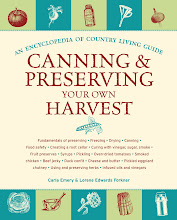Picking, Drying, Cider, Ketchup, and Butter
SECRETS OF APPLE PICKING
1. Pick on a dry day because damp fruit is more likely to spoil.
2. Store fruit in a cool place soon after it is picked.
3. For safety's sake, pick into something that leaves your hands free. This could be a bucket hanging from your belt, or a fruit-bag that fastens around your waist and hangs like an apron down your front.
4. For least bruising and best condition, pick each fruit by hand.
5. Bend the fruit upward. Twist gently to free it from the branch. A ripe fruit should easily separate. Keep the stem in the fruit. If pulled out, rot can develop in the hole.
DRYING APPLES
You have to slice them; they aren't dried whole. Fully ripe sweet apples are ideal. Usually they are peeled and cored and what's left is made into doughnut-type rings about 1/4-inch thick to oven dry, 1/8-inch to sun dry. Let the slices fall into cold water while you are working to prevent "rusting," 1/4 c. lemon juice or 1 t. ascorbic acid per 2 c. cold water. If your apples are small, wormy, or too mealy to make into doughnut rings, cut into slices of whatever shape you can. Old-timers then strung them on a thread and hung them in the sun, but now we usually just spread them out on a surface. Using an oven or dehydrator, dry them at 140° F on a cookie sheet--turning once in a while--until they are leathery.
UNPRESSED CIDER
You’ll need about a bushel of apples to make each 2-2½ gal. cider (or “juice”). Any kind of apples can be used, and you can try different blends for the sweetness-tartness qualities you prefer. Professional cider makers or serious hobbyists can get really picky about how much of what kind of apple, but hey, it’s all apple juice. The important thing is to find a way to make use of what you have. In general, good eating apples are also the best cider apples. The only apples you seriously shouldn’t use are sprayed apples, partly rotten apples, or apples that have been lying on the ground very long.
Even if you don't have a cider press you can make cider. Clean and cut your apples. Put them through a grinder or chopper, saving all the juice, and then squeeze your grindings through a strong cloth bag.
APPLE KETCHUP
Peel and quarter a dozen round, tart applies. Stew until soft in as little water as possible. Sieve them. For every quart of sieved apple, add 1 c. sugar, 1 t. pepper, 1 t. cloves, 1 t. mustard, 2 t. cinnamon, 2 medium-sized onions--chopped very fine, 1 T. salt, and 2 c. vinegar.
APPLE-PLUM BUTTER
Use from 2 to 3 times as many apples as plums. Cut up the fruit and cook in a little water until tender. Then put it through the colander. Add sweetening. Continue cooking until the butter is thick enough to deserve the name. This is Mike's favorite. He likes it on waffles or pancakes or toast, and so do I and the children.
[Adapted from "Temperate-Zone Fruits" in Chapter 6: Tree, Vine, Bush and Bramble. Illustration copyright 1994 by Cindy Davis]
[Adapted from "Temperate-Zone Fruits" in Chapter 6: Tree, Vine, Bush and Bramble. Illustration copyright 1994 by Cindy Davis]









No comments:
Post a Comment